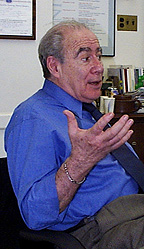
| T H E N I H C A T A L Y S T | M A Y - J U N E 2000 |
|
|
|
From the Cloning Frontier:CLONE RANGERS UP AGAINST A WALL |
by Celia Hooper |
 |
|
Norton Zinder
|
Norton Zinder, retired (but unretiring) virologist from New York’s Rockefeller University and a member of the National Academy, has ventured to the Wild West–like frontier of mammalian cloning and has a story for NIH: "There’s hard, good, interesting science there," he says, but the people working in the field, by and large, are not pursuing it.
Zinder recently co-organized a meeting, "Mammalian Cloning: Biology and Practice," that brought together—in many instances, for the first time—the biggest names in cloning. Speakers included Ian Wilmut and former colleagues who created Dolly (see The NIH Catalyst, May–June 1997); cloners of mice, pigs, and cows; would-be cloners of rats and primates; basic scientists studying early development; and a few philosophers of science. Co-organizers of the meeting, held March 12–15 at the Cold Spring Harbor (N.Y.) Banbury Center, were Peter Mombaerts, also of Rockefeller; Neal First, of the University of Wisconsin, Madison; and Jan Witkowski, Banbury Center director. In early May, Zinder came to NIH to discuss the meeting informally with NIH scientific leaders and colleagues.
"There are so many questions!" Zinder raves. "There’s new science to be found." But, unfortunately, what is steering the research, he contends, is not interest in fundamental mechanisms in development, but goals such as making sheep that produce Factor IX or pigs whose histocompatible organs can be transplanted into humans. Others at the conference say this characterization is unfair. Logistics—the cost of maintaining a herd of large animals and their longer gestation periods—make these models impractical for solving basic research questions compared to the mouse, which in turn is a recent and difficult cloning subject.
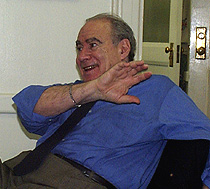 |
|
For Zinder,
to solve the mystery of the competent nucleus is far more alluring than,
say, creating animal drug factories.
|
Zinder says the central mystery emerging from cloning is what he calls "the wall"—the extremely low success rates in producing viable cloned mammals. In the species that have been cloned—sheep, mice, pigs, goats, and cows—the very best cloning techniques typically produce in the neighborhood of one or two newborn animals for every 100 oocytes in which nuclear transfer is attempted. Some species, including primates, rabbits and rats, cannot be cloned by any nuclear transfer techniques tried to date. (Identical animals of these and other species have been produced by splitting apart embryos after just a couple of cell divisions.) The cloned animals that are born are sometimes abnormally large with large placentas. They are beset with respiratory and immunological problems and, typically, half of the newborn clones die in their first days of life
To clone a mammal, scientists typically start with ripe oocytes from which they have removed the nucleus via micropipette. How much permanent damage is done to the host egg cell during enucleation is unknown. Replacement nuclei are then inserted into the oocytes or enter when a diploid donor cell is fused to the oocyte. The oocyte is stimulated with a chemical or electrical shock, then allowed to develop to the blastula stage in vitro.
The donor cells and nuclei usually come from fetal fibroblasts or Sertoli or cumulus cells—the layers of parent cells that feed sperm- and oocyte-generating cells, respectively. Other adult-derived nuclei may also be "competent" to progress all the way through development to live birth, but Zinder says the exact nature of such cells and competence is unknown. Also unknown, he says, are the optimal cell cycle stages for host cell and donor nucleus. He says there is some hint that these must match.
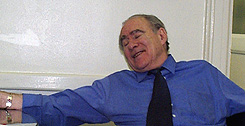 |
|
There's gold
in them thar failures, Zinder observes.
|
Most of the altered oocytes will not reach the blastula stage. Those that do are implanted in a surrogate mother. The hurdles do not end there. Implanted embryos may perish at any of a number of points before birth with defects in placenta formation and a wide array of organ systems. While these events may discourage cloners, Zinder sees a gold mine in such failures. He suspects cloned animals that fail to develop properly could shed light on epigenetic factors important to development.
Zinder throws up his hands in exasperation when asked simple questions about the causes of "the wall" that are being brushed off in the scurry to clone transgenic animals. What is the role of methylation and appropriate "reprogramming" of genes in the somatic nuclei that are transferred into the enucleated oocytes? Is telomere length a factor? How important are accumulated somatic mutations and the overall state of repair of the DNA from donor nuclei? How important are the mitochondria and the hoards of mRNA packed into oocyte cytoplasm? "They don’t know," Zinder maintains. It’s not even clear whether "the wall" is the result of one or two major problems, or an accumulation of numerous insults to recipient oocyte and donor nucleus, he says.
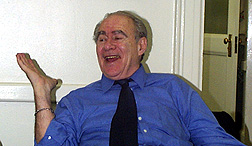 |
|
'Who knows?'
seems to be the answer to scores of crucial questions, Zinder says.
|
Based on indirect evidence in the mouse from Rudolf Jaenisch’s lab at MIT, Zinder says he suspects imprinting anomalies are a key problem. In a paper by Tucker et al. (Genes & Devel. 10, 1008, 1996), the group showed that post-zygotic nuclei—which should presumably include donor nuclei in clones—lack the enzymatic machinery to reset the methylation on imprinted genes they examined, in contrast to nonimprinted genes. During implantation, nonimprinted genes undergo massive de-methylation and re-methylation, correcting random demethylation errors that accumulate over time. Random demethylation hits to imprinted genes—normally corrected during gametogenesis—would not be fixed. "At this point, disturbed imprinting seems to be a plausible hypothesis that could explain the frequent late gestation failure of clones," Jaenisch told The NIH Catalyst via e-mail. "But we need to get direct evidence for it."
In a PNAS article in February, Mario Capecchi of the University of Utah in Salt Lake City proposes that how quickly the egg begins to divide—or more correctly, how fast the nucleus must be reprogrammed—might explain why cloning mice appears to be even less successful than cloning larger animals. Capecchi writes, "One factor that might contribute to a difference in cloning efficiency is a possible timing difference associated with the very early cell divisions as to how rapidly the zygotic gene products are required to sustain normal development in various species."
One of the biggest hits at the Cold Spring Harbor symposium, Zinder says, was a technique discussed by Eric Overstrom of Tufts University School of Veterinary Medicine in North Grafton, Mass. Unpublished experiments in Overstrom’s lab suggest that demecolcine can be used to enucleate oocytes chemically, and perhaps more gently, than a micropipette. Application of the substance to oocytes caused them to jettison their nuclei, Zinder says, adding that other labs are studying whether chemical enucleation can improve cloning success rate.
Another concern of cloners—that clones derived from nuclei from aged somatic cells would prove to be genetically "old"—was dissipated by an article in Science just days before Zinder visited NIH. Robert Lanza at Advanced Cell Technology, Worcester, Mass., and colleagues, reported that the group cloned six calves from senescent donor cells. The donor nuclei were derived from fetal calf cells that had been dividing in culture for several months. When the cells were within 0 to 2 divisions of their expected life span, the scientists extracted almost 1,900 nuclei and transplanted them to oocytes. The six calves that resulted were healthy at 2 months of age. The telomeres of the calves’ cells were measured 5 to 10 months after birth and actually appeared longer than telomeres of normally bred calves. A news story in the same Science issue (April 28, 2000) indicates that unpublished reports from other labs will confirm the telomere finding.
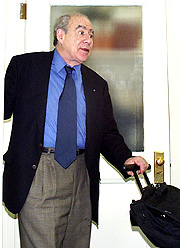 |
|
Norton Zinder
heads out.
|
NIDCD director James Battey, who attended the cloning meeting, says that although they were not well represented at the meeting, "There are a lot of people interested in the mechanisms that underlie reprogramming of the nucleus in development." The mix of people at the conference was perhaps too heavily weighted toward applied science "given our profound ignorance of reprogramming within the nucleus." Battey says he does not begrudge the cloners their single-minded pursuit of efficient, cost-effective nuclear transfer because the therapeutic uses of cloned transgenics "could contribute to the health of the nation in a big way." But Battey thinks that ultimately the cloners will need to address "the wall."
"The overall answer to making cloning efficient," he observes, "will come from understanding the basic mechanisms in silencing expression of genes in a somatic cell" and then converting the cell’s program to pluripotency—the ability to recapitulate the entire development of an organism.
Reflecting on his sojourn
in the wild world of cloning, Zinder says he is now headed in other directions
and won’t be roped in to any more roundups. He has urged the cloners to
plan a more open meeting next time, one that could attract more early-career
and basic scientists. "I’d like to get [scientists] interested in
this as a way to look at developmental biology. The field is interesting in
ways other than most current practitioners see it," he says. "The
only way to do new science is to get the kids into it—the postdocs and
grad students." ![]()